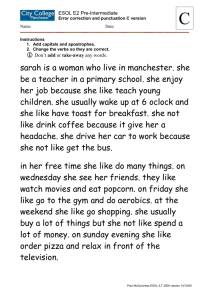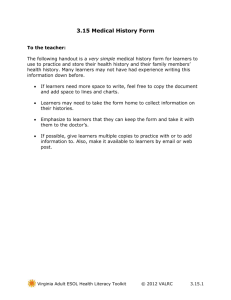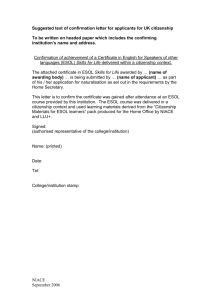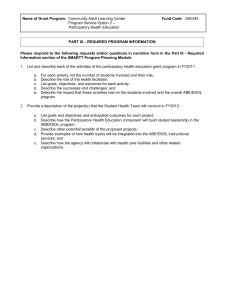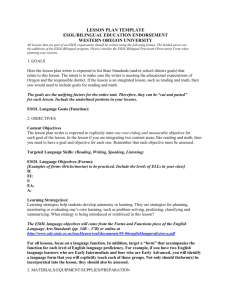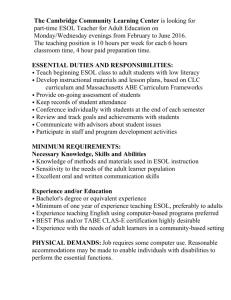Nancy Faux
advertisement
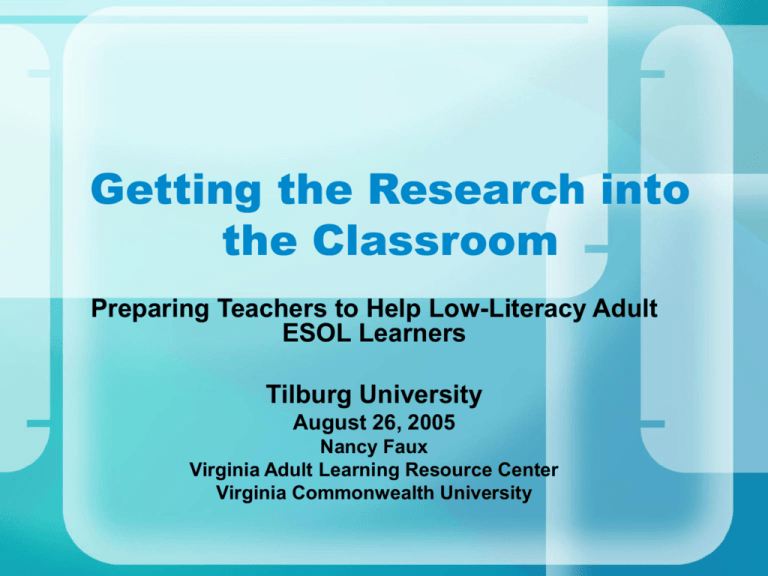
Getting the Research into the Classroom Preparing Teachers to Help Low-Literacy Adult ESOL Learners Tilburg University August 26, 2005 Nancy Faux Virginia Adult Learning Resource Center Virginia Commonwealth University Virginia • Some General Demographics* • Total adult population that speaks only English – 4,741,805 • ELL population 18 years +: 127,015 • Of these: – Less than 9th grade ed. - 44,565 (35 %) – Grad. or prof. degree – 5,015 (4 %) – Management + professional jobs – 8,260 (11.5 %) – Service jobs – 24,855 (35 %) • Linguistically isolated households: 24,805 (65 %) *Data from: U.S Department of Labor Languages Spoken by ELL’s (In order of importance) • • • • • • Spanish Vietnamese Korean Chinese Arabic Russian Adult ESOL Programs (’03-’04) Levels # of students Beginning Literacy 2,613 Beginning 2,904 Intermediate Low 2,053 Intermediate High 1,771 Advanced Low 1,832 Advanced High 895 Total 12,068 Challenges of Emerging Areas • Until now, homogenous populations • Rural locations • Distant from resources • Lower economic levels • Newcomers are less educated, agricultural workers • Most ESOL teachers do not have experience or training to work with low-literacy adult learners. Current Help to Teachers • Regional workshops • Online courses (ESOL Basics) • Summer Institutes • Publications (ESOL Starter Kit) • Web site (http://www.aelweb.vcu.edu) • Adult ESOL Content Standards ESOL Basics Online • 8-week course (32 hours) on teaching ESOL using a learning management system, Blackboard • Facilitated, asynchronous • Threaded discussions • Assignments • Many resources; websites ESOL Basics Content • • • • • Focus on life-skills Teaching 4 skills Assessing Ls needs Multi-level classes Working with low-literacy learners; learners with non-Roman alphabet L1 Certificate for Teaching Adult ESOL • Prepares Virginia educators to provide adult non-native speakers of English with competency-based, researchdriven English language instruction. Certificate: • • • • • • • Graduate level courses 22 credits Cohort Blended modality 1-2 face to face sessions Rest facilitated online Each course is 7-10 weeks Certificate: • Concentration on teaching life skills and using distinct pedagogical techniques to address the lack of literacy in L1. Courses: • Orientation • Second Language Acquisition • English Linguistics for Adult ESOL Instructors • Cross-cultural Education • Methodology in Adult ESOL Courses (2) • Adult Second Language Instruction • Teaching Reading to Adult English Language Learners • Practicum Traditional ESOL Instruction • • • • • Focuses on grammar Presupposes literacy in L1 Emphasizes accuracy Textbook-driven Activities are usually individual or full-group • Teacher decides content and structure of course. Life skills based ESOL Instruction • Task/function based • Language/communication skills for everyday tasks • Learners’ needs drive course content • Extra supports for lowliteracy learners Life skills based ESOL Instruction (2) • Emphasizes fluency (i.e., ability to communicate) • Materials represent reallife contexts (housing, health, community) • Learners work cooperatively in pairs or groups Language Experience ApproachLEA • Uses prompts or activities (e.g. pictures) • Uses Ss own words, experiences to create story • Ss decide on content • Ss negotiate to come up with story • Promotes integration of 4 skills LEA procedures: • T elicits details from each frame • T writes on board as Ss retell story • Class can practice reading it chorally or individually • Ss copy it down • Ext. activities: lexical development, phonics exercises, dictation, etc. Correctional Education • 31,000 inmates with language skills accessed • 13,434 enrolled in DCE classes • 90 % has a functional literacy level below 8th grade • 24 % completion rate • Plazas Comunitarias for Hispanics Other Literacy Contexts to Consider • Family Literacy • Financial Literacy • Health Literacy What teachers need is … Access to: • Scientifically-based research on second language acquisition in adults, • Results of what works and explicit literacy impact studies, • Special curriculum for low-literate learners.

